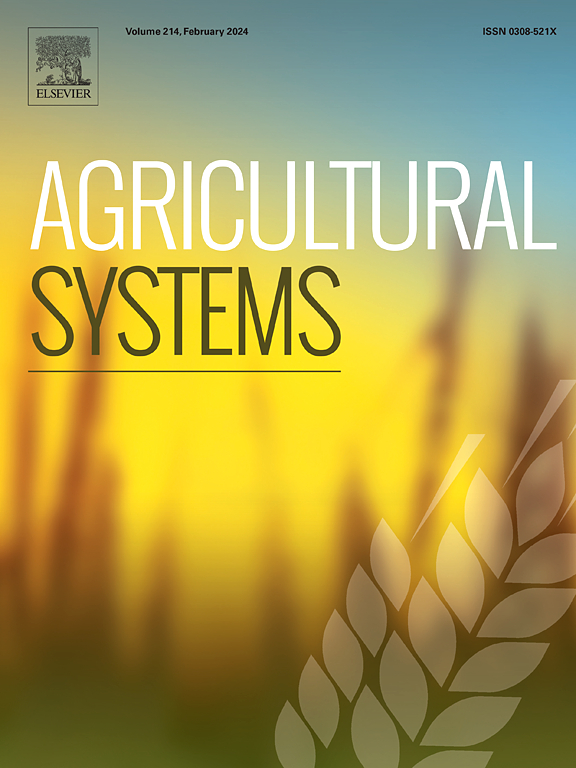When arable land is the limit: Paths for future livestock production – An example from Norway
IF 6.1
1区 农林科学
Q1 AGRICULTURE, MULTIDISCIPLINARY
引用次数: 0
Abstract
Context
The global food system contributes significantly to environmental degradation, with livestock production driving greenhouse gas emissions and feed-food competition. Norway, with only 3.5 % arable land, faces challenges balancing food security with reducing environmental impacts.
Objective
This study examines future livestock production strategies in Norway to evaluate their environmental sustainability and resource efficiency. The focus is on three scenarios for 2040: TrendProd (baseline projection), MoreProd (increased productivity with circular bioeconomy initiatives), and ChangeProd (circular livestock production prioritizing food production over feed use).
Methods
Life cycle assessment was used to assess environmental impacts per kg of protein, complemented by resource efficiency evaluations through land use ratio (LUR) and nitrogen recycling index (NRI). Scenarios were analyzed at the national scale for their ability to supply animal-source foods (ASF) while reducing feed-food competition and enhancing biodiversity.
Results and conclusions
TrendProd reflected current trends, resulting in significant overproduction of animal protein relative to population needs based on dietary recommendations, along with high environmental impacts. MoreProd achieved slightly lower climate impact per kg protein, reduced biodiversity loss, and neutral land use efficiency but increased overall land use. ChangeProd prioritized low-opportunity-cost biomass, enhancing biodiversity and resource efficiency while reducing total production. This would necessitate dietary shifts to maintain domestic production sufficiency. A combination of efficiency and sufficiency strategies, supported by comprehensive policies, is essential for sustainable livestock production.
Significance
The findings highlight the potential for Norway to develop sustainable livestock systems that address environmental challenges while maintaining food security. The ChangeProd scenario provides a model for balancing food production with sustainability goals, offering insights for other countries facing similar challenges.

当可耕地是极限时:未来畜牧生产的路径——以挪威为例
全球粮食系统在很大程度上加剧了环境退化,畜牧业生产推动了温室气体排放和饲料食品竞争。挪威只有3.5%的可耕地,面临着平衡粮食安全和减少环境影响的挑战。目的本研究探讨了挪威未来畜牧业生产战略,以评估其环境可持续性和资源效率。重点关注2040年的三种情景:TrendProd(基线预测)、MoreProd(通过循环生物经济举措提高生产率)和ChangeProd(循环畜牧生产优先考虑粮食生产而不是饲料使用)。方法采用生命周期法评价每kg蛋白质对环境的影响,辅以土地利用率(LUR)和氮循环指数(NRI)评价资源效率。在国家尺度上分析了它们在提供动物源食品(ASF)的同时减少饲料-食品竞争和增强生物多样性的能力。结果和结论strendprod反映了当前的趋势,导致动物蛋白相对于基于膳食建议的人群需求明显过剩,同时对环境产生很大影响。MoreProd每公斤蛋白质的气候影响略低,生物多样性减少,土地利用效率中性,但增加了总体土地利用。ChangeProd优先考虑低机会成本的生物质,在降低总产量的同时提高生物多样性和资源效率。这就需要改变饮食习惯,以维持国内生产的充足性。效率和充足战略相结合,辅以综合政策,对可持续畜牧生产至关重要。研究结果强调了挪威在发展可持续畜牧业系统以应对环境挑战的同时保持粮食安全的潜力。ChangeProd情景为平衡粮食生产与可持续性目标提供了一个模型,为面临类似挑战的其他国家提供了见解。
本文章由计算机程序翻译,如有差异,请以英文原文为准。
求助全文
约1分钟内获得全文
求助全文
来源期刊

Agricultural Systems
农林科学-农业综合
CiteScore
13.30
自引率
7.60%
发文量
174
审稿时长
30 days
期刊介绍:
Agricultural Systems is an international journal that deals with interactions - among the components of agricultural systems, among hierarchical levels of agricultural systems, between agricultural and other land use systems, and between agricultural systems and their natural, social and economic environments.
The scope includes the development and application of systems analysis methodologies in the following areas:
Systems approaches in the sustainable intensification of agriculture; pathways for sustainable intensification; crop-livestock integration; farm-level resource allocation; quantification of benefits and trade-offs at farm to landscape levels; integrative, participatory and dynamic modelling approaches for qualitative and quantitative assessments of agricultural systems and decision making;
The interactions between agricultural and non-agricultural landscapes; the multiple services of agricultural systems; food security and the environment;
Global change and adaptation science; transformational adaptations as driven by changes in climate, policy, values and attitudes influencing the design of farming systems;
Development and application of farming systems design tools and methods for impact, scenario and case study analysis; managing the complexities of dynamic agricultural systems; innovation systems and multi stakeholder arrangements that support or promote change and (or) inform policy decisions.
 求助内容:
求助内容: 应助结果提醒方式:
应助结果提醒方式:


